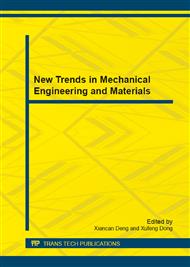p.61
p.65
p.71
p.75
p.79
p.84
p.91
p.97
p.101
Manufacturing Process Specification and Collaborative Decision-Making
Abstract:
A majority of information in manufacturing is the process information which presents mobility. Such information reflects transforming process form materials to products. This research establishes a manufacturing process information model that presents uniqueness, validness, completeness and generality based in PSL. The model can provide necessary process information and related product, material and resource information required by systems for integrating and collaborative decision making. It then enables to build a collaborative manufacturing decision making process model which is capable of utilizing the process information model. By defining logic procedure, data wrapping and service invoking in the decision making process model, multi-manufacturing systems collaborative decision making will be implemented. Such method of manufacturing process information modeling and decision making process modeling is illustrated by examples of the collaborative creation of a part process plan and an assembly process plan considering actual manufacturing environment.
Info:
Periodical:
Pages:
79-83
Citation:
Online since:
December 2012
Authors:
Keywords:
Price:
Сopyright:
© 2013 Trans Tech Publications Ltd. All Rights Reserved
Share:
Citation:


